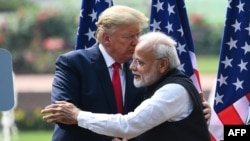As Indian Prime Minister Narendra Modi heads to the United States for a two-day visit starting Wednesday, officials in New Delhi expressed optimism that the visit will herald a renewed and substantive partnership. However analysts said there will be contentious issues to navigate on trade and immigration, which are among U.S. President Donald Trump’s top priorities.
Underlining that Modi will be meeting Trump within weeks of his taking office, Indian foreign secretary Vikram Misri said India-U.S. ties are solid and that “this has been one of our strongest international partnerships.”
Modi will reach Washington after visiting France, where he is attending a global conference on artificial intelligence.
Trade is important for both countries and India has taken steps to demonstrate that it is ready to address concerns of Trump, who has named India among countries that are “very big tariff abusers.” In a phone conversation with Modi last month, Trump called for moving toward a fair bilateral trading relationship.
His top economic adviser, Kevin Hassett, repeated such concerns on Monday. "India has enormously high" tariffs that lock out imports, he said in an interview with CNBC.
New Delhi, which wants to avoid trade tensions with the U.S., announced earlier this month that it will lower import duties on some items that will benefit American exports such as high-end motorcycles and cars.
It also may offer other concessions that could help American goods gain market access to India and boost energy imports from the U.S., say analysts.
“New Delhi thought it would take a first step and try to resolve differences on trade. But, certainly, as a great negotiator and bargainer, he [Trump] will ask for more,” said Chintamani Mahapatra, founder of the Kalinga School of Indo Pacific Studies. “India also bargains very well. So, somehow, we will try to make a compromise that will benefit both.”
For India, the stakes are high — the U.S. is its largest trading partner. Bilateral trade between the two countries was $118 billion, with a surplus of about $32 billion in India’s favor in 2023.
India has not been impacted so far by Trump’s tariff impositions — the latest 25 percent tariffs he imposed on steel and aluminum imports will have merely a marginal impact on India, as New Delhi is a small exporter of steel to the U.S., according to Indian officials.
Strengthening security and defense ties with the U.S., Indian officials say will also be discussed in Washington. According to analysts that could include potential purchases of weapon systems and technology. In the recent phone conversation with Modi, President Trump had called on Modi to increase procurement of American-made security equipment.
India, the world’s largest importer of military equipment, needs a range of weapons systems to modernize its military. As it diversifies its purchases from its traditional weapons supplier, Russia, India has been purchasing more arms from countries like France, Israel and the United States.
“The U.S. is a little concerned that it is losing out on the India [security] buys, so it has stepped up pressure to sell India a lot more defense equipment than India has bought in the last few years,” according to Rahul Bedi, defense analyst in New Delhi. “There is likely to be initiatives on transport aircraft, surveillance aircraft for the navy, and possibly even fighter aircraft, as well as a lot of technology transfers for aircraft engines, infantry combat vehicles.”
Immigration is another issue of concern to both countries. Although India has cooperated with the U.S. and said it is ready to take back undocumented migrants, reports of 104 undocumented Indians being shackled for 40 hours while being brought back to India on a military plane last week from the U.S. led to an uproar and protests by opposition parties.
Indian officials have said that New Delhi will call for better treatment during future deportations.
At the same time, India’s top priority during discussions will be to protect legal channels of immigration for skilled Indian workers and students heading to American universities. Indians are the largest beneficiaries of H1B visas, which allow U.S. employers to hire foreign professionals in specialized fields, such as technology.
“People-to-people relationships constitute the bedrock of our deepening ties with the United States,” Indian foreign minister, Subrahmanyam Jaishankar told lawmakers, while responding to concerns about the transport and treatment of the deportees.
In a statement before leaving New Delhi, Modi called his upcoming meeting with Trump an opportunity to build upon the successes of their collaboration in Trump’s first term.
Mutual concerns about an assertive China are likely to keep the two countries aligned, according to analysts. Along with the U.S., Australia and Japan, India is a partner in the Quad, a strategic security grouping focused on the Indo-Pacific. Analysts point out that the two countries have convergence on geostrategic issues.
“It was president Trump in his first term, who dusted off the Quad, which was in a dormant state for about ten years, and he was solely responsible for reviving it,” said Mahapatra. “This is an area where both the countries have a lot of things in common for maintaining peace, stability and contributing to the growth story in the Indo-Pacific region.”











